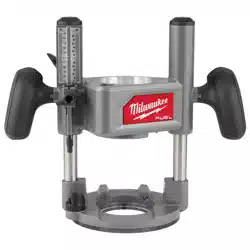Loading ...
Loading ...

3
• When battery pack is not in use, keep it away
from other metal objects, like paper clips, coins,
keys, nails, screws or other small metal objects,
that can make a connection from one terminal
to another. Shorting the battery terminals together
may cause burns or a re.
• Under abusive conditions, liquid may be ejected
from the battery; avoid contact. If contact acciden-
tally occurs, ush with water. If liquid contacts
eyes, additionally seek medical help. Liquid
ejected from the battery may cause irritation or burns.
• Do not use a battery pack or tool that is dam-
aged or modied. Damaged or modied batteries
may exhibit unpredictable behavior resulting in re,
explosion or risk of injury.
• Do not expose a battery pack or tool to re or
excessive temperature. Exposure to re or tem-
perature above 265°F (130°C) may cause explosion.
• Follow all charging instructions and do not charge
the battery pack or tool outside the temperature
range specied in the instructions. Charging im-
properly or at temperatures outside the specied range
may damage the battery and increase the risk of re.
SERVICE
• Have your power tool serviced by a qualied
repair person using only identical replacement
parts. This will ensure that the safety of the power
tool is maintained.
• Never service damaged battery packs. Service
of battery packs should only be performed by the
manufacturer or authorized service providers.
SPECIFIC SAFETY RULES FOR
ROUTERS
•Use clamps or another practical way to secure
and support the workpiece to a stable platform.
Holding the work by your hand or against the body
leaves it unstable and may lead to loss of control.
•Always hold the tool rmly in your hand(s) during
the start-up. The reaction torque of the motor, as it
accelerates to full speed, can cause the tool to twist.
•Maintain a rm grip on the power tool and position
your body and arm to allow you to resist kickback
forces. The operator can control kickback forces, if
proper precautions are taken.
• Some woods contain preservatives that can be
toxic. Take extra care to prevent inhalation and skin
contact when working with these materials. Request,
and follow, any safety information available from your
material supplier.
• Never hold the workpiece in one hand and the tool
in the other hand when using the tool. Never place
hands near or below cutting surface. Clamping
the material and guiding the tool with both hands is
safer.
• Never use dull or damaged bits. Sharp bits must
be handled with care. Damaged bits can break
during use. Dull bits require more force to push the
tool, which could cause the bit to break. Damaged
bits can throw carbide pieces and burn the workpiece.
• After changing the bit or making any adjust-
ments, make sure the collet nut and any other
adjustment devices are securely tightened. Loose
adjustment devices can unexpectedly shift, causing
loss of control. Loose rotating components will be
violently thrown. Watch for vibration or wobbling that
could indicate an improperly installed bit.
• Never start the tool when the bit is in contact
with the material. The bit cutting edge may grab
the material causing loss of control of the tool.
• Never lay the tool down until the bit has come
to a complete stop. The spinning bit can grab the
surface and pull the tool out of your control.
• Never touch the bit during or immediately after
use. After use the bit, collet, and collet nut may be
hot enough to burn bare skin.
• Never clamp the workpiece to a hard surface,
such as concrete or stone. Contact with the bit
could cause the tool to jump and loss of control.
• Only operate the router when held. Do not clamp or
secure the router to a surface and hold the workpiece
by hand.
• Never use bits larger than the smallest of the
openings in the base, sub-base, or dust collection
port.
• Do not loosen or remove the
Plunge base
caps
plunge base caps. Internal springs
are under pressure. If loosened or
removed, the plunge base caps
and internal springs will become
projectiles, which could cause in-
jury.
• Never use the router with a router table or router
lift. Serious injury or product damage may occur.
•
WARNING
To reduce the risk of injury, when
working in dusty situations, wear
appropriate respiratory protection or use an
OSHA compliant dust extraction solution.
• To reduce the risk of explosion, electric shock
and property damage, always check the work
area for hidden pipes and wires before routing.
• Avoid open area of router base. Serious personal
injury will result from contact with a rotating bit.
• Always use common sense and be cautious when
using tools. It is not possible to anticipate every
situation that could result in a dangerous outcome.
Do not use this tool if you do not understand these
operating instructions or you feel the work is beyond
your capability; contact Milwaukee Tool or a trained
professional for additional information or training.
• Maintain labels and nameplates. These carry
important information. If unreadable or missing,
contact a MILWAUKEE service facility for a free
replacement.
•
WARNING
Some dust created by power sanding,
sawing, grinding, drilling, and other
construction activities contains chemicals known to
cause cancer, birth defects or other reproductive
harm. Some examples of these chemicals are:
• lead from lead-based paint
• crystalline silica from bricks and cement and other
masonry products, and
• arsenic and chromium from chemically-treated
lumber.
Your risk from these exposures varies, depending on
how often you do this type of work. To reduce your
exposure to these chemicals: work in a well ventilated
area, and work with approved safety equipment, such
as those dust masks that are specially designed to
lter out microscopic particles.
Loading ...
Loading ...
Loading ...
